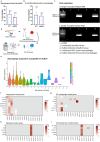Transcriptional profiling of zebrafish intestines identifies macrophages as host cells for human norovirus infection
- PMID: 39584740
- PMCID: PMC11591593
- DOI: 10.1080/19490976.2024.2431167
Transcriptional profiling of zebrafish intestines identifies macrophages as host cells for human norovirus infection
Abstract
Human noroviruses (HuNoVs) are a major cause of diarrheal disease, yet critical aspects of their biology, including cellular tropism, remain unclear. Although research has traditionally focused on the intestinal epithelium, the hypothesis that HuNoV infects macrophages has been recurrently discussed and is investigated here using a zebrafish larval model. Through single-cell RNA sequencing of dissected zebrafish intestines, we unbiasedly identified macrophages as host cells for HuNoV replication, with all three open reading frames mapped to individual macrophages. Notably, HuNoV preferentially infects actively phagocytosing inflammatory macrophages. HuNoV capsid proteins and double-stranded RNA colocalized within intestinal macrophages of infected zebrafish larvae, and the negative-strand RNA intermediate was detected within FACS-sorted macrophages. Flow cytometry confirmed viral replication within these macrophages, constituting approximately 23% of HuNoV's host cells. Identifying macrophages as host cells prompts a reevaluation of their role in HuNoV pathogenesis, offering new directions for understanding and controlling this infection.
Keywords: Human norovirus; cellular tropism; host cell identification; host-virus interaction; intestinal epithelium; macrophages; zebrafish larval model.
Conflict of interest statement
No potential conflict of interest was reported by the author(s).
Figures







References
-
- Liu L, Johnson HL, Cousens S, Perin J, Scott S, Lawn JE, Rudan I, Campbell H, Cibulskis R, Li M, et al. Global, regional, and national causes of child mortality: an updated systematic analysis for 2010 with time trends since 2000. Lancet. 2012;379(9832):2151–25. doi:10.1016/s0140-6736(12)60560-1. - DOI - PubMed
MeSH terms
LinkOut - more resources
Full Text Sources
Medical
Molecular Biology Databases
